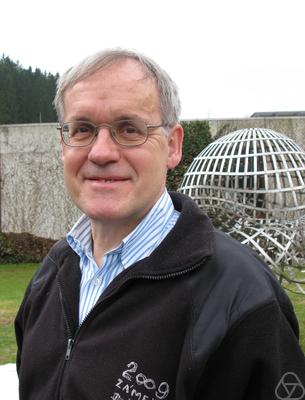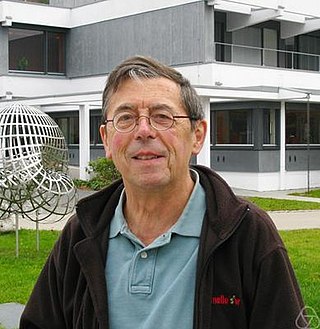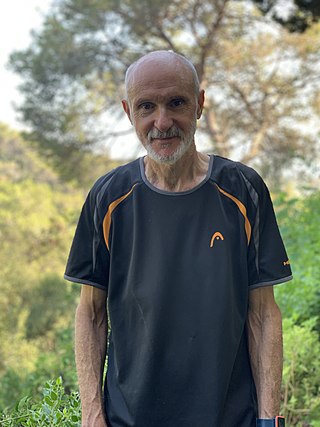The John von Neumann Theory Prize of the Institute for Operations Research and the Management Sciences (INFORMS) is awarded annually to an individual who has made fundamental and sustained contributions to theory in operations research and the management sciences.

Linear programming (LP), also called linear optimization, is a method to achieve the best outcome in a mathematical model whose requirements are represented by linear relationships. Linear programming is a special case of mathematical programming.

A greedy algorithm is any algorithm that follows the problem-solving heuristic of making the locally optimal choice at each stage. In many problems, a greedy strategy does not produce an optimal solution, but a greedy heuristic can yield locally optimal solutions that approximate a globally optimal solution in a reasonable amount of time.
An integer programming problem is a mathematical optimization or feasibility program in which some or all of the variables are restricted to be integers. In many settings the term refers to integer linear programming (ILP), in which the objective function and the constraints are linear.
The Fulkerson Prize for outstanding papers in the area of discrete mathematics is sponsored jointly by the Mathematical Optimization Society (MOS) and the American Mathematical Society (AMS). Up to three awards of $1,500 each are presented at each (triennial) International Symposium of the MOS. Originally, the prizes were paid out of a memorial fund administered by the AMS that was established by friends of the late Delbert Ray Fulkerson to encourage mathematical excellence in the fields of research exemplified by his work. The prizes are now funded by an endowment administered by MPS.

Jack R. Edmonds is an American-born and educated computer scientist and mathematician who lived and worked in Canada for much of his life. He has made fundamental contributions to the fields of combinatorial optimization, polyhedral combinatorics, discrete mathematics and the theory of computing. He was the recipient of the 1985 John von Neumann Theory Prize.
In mathematical optimization and related fields, relaxation is a modeling strategy. A relaxation is an approximation of a difficult problem by a nearby problem that is easier to solve. A solution of the relaxed problem provides information about the original problem.
Thomas Lee Magnanti is an American engineer and Institute Professor and former Dean of the School of Engineering at the Massachusetts Institute of Technology.
Alan Jerome Hoffman was an American mathematician and IBM Fellow emeritus, T. J. Watson Research Center, IBM, in Yorktown Heights, New York. He was the founding editor of the journal Linear Algebra and its Applications, and held several patents. He contributed to combinatorial optimization and the eigenvalue theory of graphs. Hoffman and Robert Singleton constructed the Hoffman–Singleton graph, which is the unique Moore graph of degree 7 and diameter 2.
Ellis Lane Johnson is the Professor Emeritus and the Coca-Cola Chaired Professor in the H. Milton Stewart School of Industrial and Systems Engineering at Georgia Institute of Technology in Atlanta, Georgia.

Fred Glover is Chief Scientific Officer of Entanglement, Inc., USA, in charge of algorithmic design and strategic planning for applications of combinatorial optimization in quantum computing. He also holds the title of Distinguished University Professor, Emeritus, at the University of Colorado, Boulder, associated with the College of Engineering and Applied Science and the Leeds School of Business. He is known for his innovations in the area of metaheuristics including the computer-based optimization methodology of Tabu search, an adaptive memory programming algorithm for mathematical optimization, and the associated evolutionary Scatter Search and Path Relinking algorithms.
In applied mathematics, branch and price is a method of combinatorial optimization for solving integer linear programming (ILP) and mixed integer linear programming (MILP) problems with many variables. The method is a hybrid of branch and bound and column generation methods.
Selmer Martin Johnson was an American mathematician, a researcher at the RAND Corporation.

Alexander (Lex) Schrijver is a Dutch mathematician and computer scientist, a professor of discrete mathematics and optimization at the University of Amsterdam and a fellow at the Centrum Wiskunde & Informatica in Amsterdam. Since 1993 he has been co-editor in chief of the journal Combinatorica.

Laurence Alexander Wolsey is an English mathematician working in the field of integer programming. He is a former president and research director of the Center for Operations Research and Econometrics (CORE) at Université catholique de Louvain in Belgium. He is professor emeritus of applied mathematics at the engineering school of the same university.

Michel Louis Balinski was an American and French applied mathematician, economist, operations research analyst and political scientist. Educated in the United States, from 1980 he lived and worked in France. He was known for his work in optimisation, convex polyhedra, stable matching, and the theory and practice of electoral systems, jury decision, and social choice. He was Directeur de Recherche de classe exceptionnelle (emeritus) of the C.N.R.S. at the École Polytechnique (Paris). He was awarded the John von Neumann Theory Prize by INFORMS in 2013.

Gérard Pierre Cornuéjols is the IBM University Professor of Operations Research in the Carnegie Mellon University Tepper School of Business. His research interests include facility location, integer programming, balanced matrices, and perfect graphs.
Aurelie or Aurélie Thiele is a French engineering and decision-making professor. She is an associate professor in the engineering management and information and systems department at the Lyle School of Engineering of Southern Methodist University.

Shmuel Onn is a mathematician, Professor of Operations Research and Dresner Chair at the Technion - Israel Institute of Technology. He is known for his contributions to integer programming and nonlinear combinatorial optimization.
The welfare maximization problem is an optimization problem studied in economics and computer science. Its goal is to partition a set of items among agents with different utility functions, such that the welfare – defined as the sum of the agents' utilities – is as high as possible. In other words, the goal is to find an item allocation satisfying the utilitarian rule.









